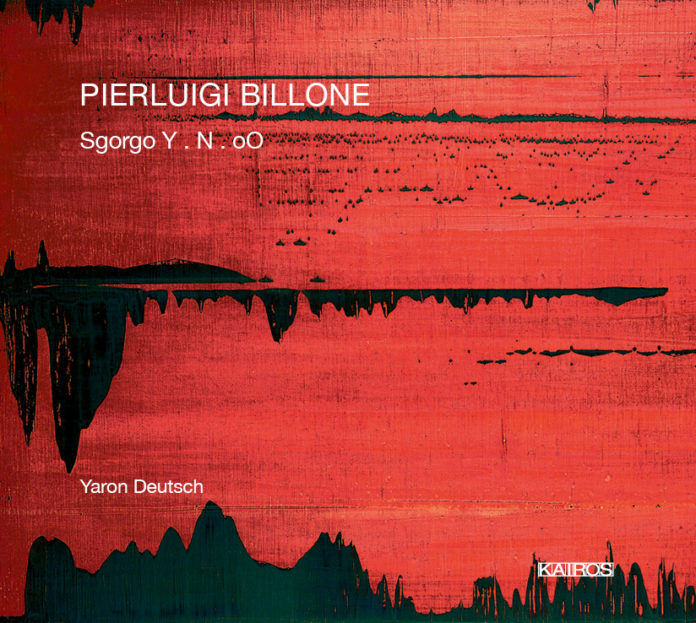A good analysis of the new cycle of Pierluigi Billone‘s compositions for electric guitar and effects, can be well comprehended by the words of guitarist Yaron Deutsch. In the inner booklet of the CD, it is learned that Deutsch had the courage to ask the Italian composer if he was interested in writing a piece for electric guitar; Billone’s response was typical: “… If I write a piece for electric guitar, it will be in the spirit of Allan Holdsworth…“. So, the problem is to understand how this spirit can be catapulted into academic music for the purposes of a guitarist who has made his fortune in jazz-rock, a genre seemingly far from classical music. The British musician’s work has satisfied several areas: in the reconstructed Lifetime, the second group of the jazz drummer Tony Williams, Holdsworth was able to make electric guitar lovers crazy with his powerful plots and his fast legato (a legacy taken from the jazz saxophonists that he transferred to his solo practice with regularity from 1980 onwards); he satisfies technique because he was first to use the Synthaxe, a particular type of synthesized guitar, able to simulate the sounds of an ancient or new keyboard (from a harpsichord to a piano) and above all, symphonic sounds activated jointly by an added alternative system on the body of the instrument and by movement of the left hand only on the guitar neck; he satisfied good music’s lovers especially when he decreased the weight of symphonic texture and augmented ordinary ways of expression, i.e., in a mix of omnipotence and gloom, quite different from that of guitarists of the same genre as Ritenour or Di Meola (they both have made extemporaneous use of Synthaxe, but they were more focused on aspects of popular music).
In the triptych of Billone we can find resemblances via a modern representation of the Synthaxe, replaced here by an electric guitar multi-effects processor and especially on Holdsworth’s leaden mood, not always objectifiable from listening to his music: Billone writes his compositions emulating (for the entire duration of the composition) a part of Holdsworth’s style, i.e. he writes scores for the left hand alone, and together with Deutsch, studies possible expressive musical worlds: the relationship is between the conventional guitar sound and some specific responses from the device: the technological limitations of the latter are the main subject of their investigation. Billone avoids the rhetorical effects such as wah-wah or childish distortions, giving priority to his compositional vision, a musical “magnitudo” transferred to the instrument, music as heat conductor. He promotes the collision, the attack and the size of harmonic sounds. Sgorgo Y is really a masterpiece–it has a hyper character in its development, where the rapid changes of the score seem conceptually to hide a futuristic voice, a biological drift where the elements have lost their original cellular entities, while Sgorgo N tries to find Luigi Nono’s traces in a slow and plaintive contrast between guitar and its effects, which offers, in the end, an opportunity to the materials and timbres to explode in a magnificent state of repressed despair; Sgorgo oO explores new fields of action and suggests that this conflictual work can be thorough-going. Needless to say that we must come to terms with the fact that for further developments on the electrical side of the guitar, Billone’s discoveries will become an indispensable reference point as of today.
_______________________________________________________________________IT
Per un’analisi centrata del ciclo di tre composizioni per chitarra elettrica ed effetti di Pierluigi Billone, è necessario partire dalle parole del suo esecutore, Yaron Deutsch. Nel libretto esplicativo interno al cd Deutsch ebbe il coraggio di chiedere, al suo primo incontro con il compositore italiano, se fosse interessato a scrivere un pezzo per chitarra elettrica; la risposta di Billone fu emblematica: “…If I write a piece for e-guitar, it will be in the spirit of Allan Holdsworth...”. Dunque il problema è capire come possano essere catapultate nella musica accademica le ragioni di un chitarrista che ha fatto la sua fortuna nel jazz-rock, un genere apparentemente lontano alla musica colta. Il lavoro svolto dal musicista inglese ha soddisfatto parecchi ambiti: nella ricostruzione del gruppo Lifetime del batterista jazz Tony Williams fece impazzire gli amanti della chitarra elettrica con la sua trama potente e veloce (un legato rubato ai sassofonisti jazz che fu trasferito nelle prove solistiche avvenute con regolarità dagli ottanta in poi); soddisfò la tecnica usando per primo la synthAxe, un particolare tipo di chitarra sintetizzata, capace di simulare i suoni di una tastiera antica o nuova (da un clavicembalo ad un piano) e soprattutto in grado di emulare suoni sinfonici attivabili congiuntamente da un sistema alternativo aggiunto sul corpo dello strumento e dal solo movimento della mano sinistra sulla tastiera della chitarra; soddisfò i cultori della buona musica specie nel momento in cui la pretesa sinfonica perdeva di consistenza rispetto all’ordinaria via di espressione, un mix di onnipotenza e oscurità piuttosto diverso da quella di chitarristi dello stesso genere come Ritenour o Di Meola (entrambi utilizzatori estemporanei della SynthAxe, ma concentrati maggiormente sugli aspetti popolari della musica).
Il trittico di Billone lavora per similitudine su una rappresentazione moderna della SynthAxe, sostituita da un chitarra elettrica con processore multi-effetto e soprattutto su quell’umore plumbeo di Holdsworth, non sempre oggettivabile dall’ascolto della sua musica: emulando per tutta la durata delle composizioni la generazione dei suoni con la sola mano sinistra, Billone e Deutsch hanno studiato perbene i possibili mondi espressivi determinati dalla relazione tra la convenzione chitarristica ed alcune specifiche risposte del dispositivo di effetti, restando affascinati dai limiti tecnologici di quest’ultimo. Nell’escludere a priori ritorni retorici di effetti come wah wah o distorsioni infantili, Billone ha dato priorità alla sua visione del comporre, quella magnitudo inferta agli strumenti per determinarne la loro prestanza a condurre calore musicale, privilegiando l’urto, l’attacco e le dimensioni armoniche dei suoni. Sgorgo Y è un capolavoro ed ha un hyper carattere nel suo svolgimento, dove le rapide evoluzioni della partitura sembrano nascondere concettualmente una voce futuristica, una foce biologica che ha perso la sua originaria entità cellulare, mentre Sgorgo N cerca di trovare Luigi Nono in una lenta, lamentosa contrapposizione tra chitarra e suoi effetti, dove, nel finale, la deriva biologica dei materiali e dei timbri ha persino occasione di esplodere in un magnifico stato di disperazione repressa; Sgorgo oO esplora nuovi campi di azione e lascia intendere che questo lavoro di confronto è un work in progress che può essere approfondito ulteriormente. Bisognerà farsi una ragione del fatto che per ulteriori sviluppi sul versante elettrico della chitarra, le scoperte di Billone saranno un punto di riferimento imprescindibile. Fin da ora.







